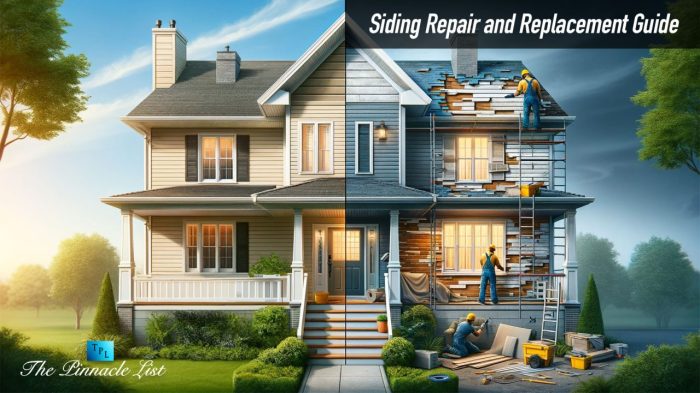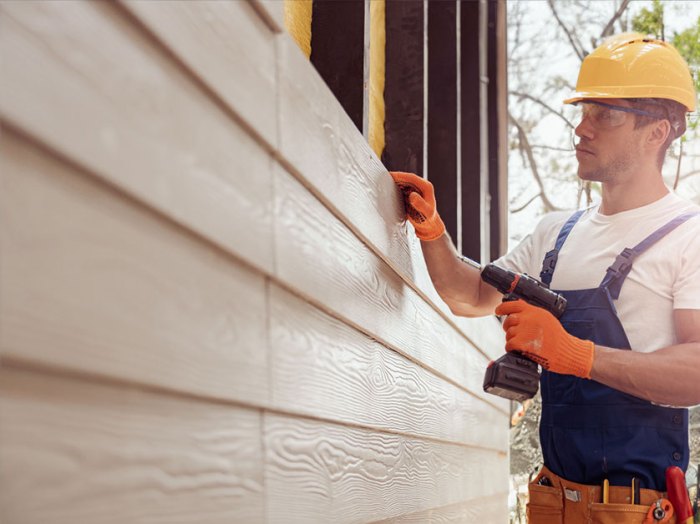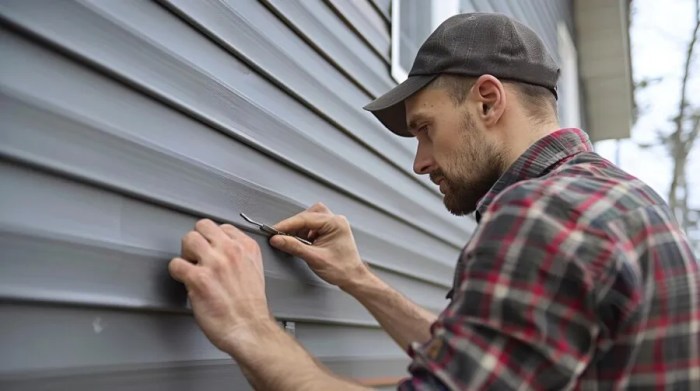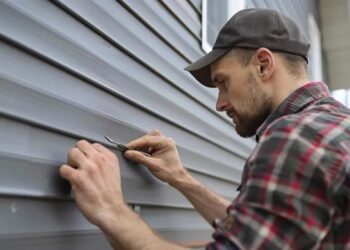Embarking on the journey of siding replacement for homeowners, this guide offers a comprehensive look at the process, benefits, and considerations involved. From signs indicating the need for replacement to tips on selecting contractors, this guide covers it all.
Exploring different siding materials, costs, maintenance tips, and more, this guide equips homeowners with essential knowledge for a successful siding replacement project.
Introduction to Siding Replacement
Replacing the siding of your home is a crucial maintenance task that can enhance both the appearance and functionality of your property. It serves as a protective barrier against the elements, ensuring the structural integrity of your house.
Signs that Indicate the Need for Siding Replacement
- Cracks or warping in the siding
- Fading or peeling paint
- Mold, mildew, or moisture damage
- Insect infestations
- Rising energy bills due to poor insulation
Benefits of Replacing Old Siding with New Materials
- Improved energy efficiency
- Enhanced curb appeal
- Increased property value
- Protection against weather damage
- Reduced maintenance and repair costs in the long run
Types of Siding Materials

When it comes to siding replacement, homeowners have several options to choose from in terms of materials. Each type of siding material has its own set of advantages and disadvantages, so it's important to consider your specific needs and preferences before making a decision.
Vinyl Siding
- Pros:
- Low maintenance
- Durable and long-lasting
- Wide range of colors and styles
- Cons:
- Can crack or fade over time
- Not as environmentally friendly as other options
- May not have the same aesthetic appeal as wood or fiber cement
Wood Siding
- Pros:
- Natural and timeless look
- Eco-friendly option
- Can be painted or stained in various colors
- Cons:
- Requires regular maintenance (painting, sealing, etc.)
- Prone to rot, pests, and warping
- Higher initial cost compared to vinyl or fiber cement
Fiber Cement Siding
- Pros:
- Durable and resistant to fire, insects, and rot
- Low maintenance
- Can mimic the look of wood or stucco
- Cons:
- Higher initial cost than vinyl siding
- Heavier and may require professional installation
- Limited color options compared to vinyl
Hiring a Contractor

When it comes to siding replacement, hiring a reputable contractor is crucial to ensure a successful and satisfactory outcome for your home. The process of selecting the right contractor involves careful consideration and research to find a skilled professional who can deliver quality work.
Checking Licenses, Insurance, and References
Before hiring a siding contractor, it is essential to check if they have the necessary licenses and insurance to perform the work legally and protect you from any liability. A reputable contractor should be able to provide proof of these documents upon request.
Additionally, asking for references from past clients can give you insight into the contractor's work quality and professionalism.
- Verify that the contractor holds a valid license to work in your area.
- Ensure that the contractor has liability insurance and workers' compensation coverage to protect you and their employees in case of accidents.
- Ask for references and follow up with past clients to inquire about their experience working with the contractor.
Obtaining Multiple Quotes and Comparing Them
To make an informed decision, it is recommended to obtain multiple quotes from different contractors and compare them based on factors such as price, materials, timeline, and warranty. This allows you to assess the value offered by each contractor and choose the one that best fits your needs and budget.
- Request detailed quotes from at least three contractors to compare pricing and scope of work.
- Consider the quality of materials proposed by each contractor and ensure they meet your expectations.
- Evaluate the timeline for the project and any warranties offered for the work done.
Siding Replacement Process
Replacing siding on a home involves several important steps to ensure a successful outcome. From preparation work to the actual installation, homeowners need to be aware of what to expect throughout the process.
Preparation Work
Before the siding replacement begins, it is crucial to prepare the house adequately. This includes removing any existing siding, inspecting the underlying structure for damage or rot, and making necessary repairs. Additionally, the area around the house should be cleared of any obstacles or debris to provide easy access for the contractors.
- Remove existing siding carefully to avoid damaging the exterior walls.
- Inspect the sheathing and framing for any signs of water damage or rot.
- Repair any damaged areas to ensure a solid foundation for the new siding.
- Clean the work area to create a safe and efficient environment for the installation.
Challenges During Replacement
While replacing siding can significantly improve the appearance and functionality of a home, homeowners may encounter some challenges along the way. It's essential to be aware of these potential obstacles to better prepare for them.
- Unforeseen structural issues: Hidden damage or rot discovered during the removal process can lead to additional repair costs.
- Weather delays: Inclement weather conditions can disrupt the installation schedule, causing delays in completing the project.
- Material availability: Depending on the chosen siding material, there may be delays in obtaining the necessary supplies due to high demand or production issues.
- Contractor coordination: Coordinating schedules with contractors and other professionals involved in the project can sometimes be challenging, leading to delays in the overall timeline.
Cost Considerations

When it comes to siding replacement, understanding the costs involved is crucial for homeowners. The total cost can vary depending on various factors, so it's important to break down these costs and factors to make informed decisions.
Factors Affecting Cost
- Size of the Home: Larger homes will require more materials, leading to higher costs.
- Choice of Siding Material: Different types of siding materials come with varying price points, impacting the overall cost.
- Additional Features: Factors like trim work, insulation, and labor costs can add to the total expenses.
- Removal of Old Siding: If the existing siding needs to be removed before installation, this process can increase the overall cost.
- Location: The cost of living in your area can affect labor costs, material prices, and overall project expenses.
Budgeting and Financing Tips
- Get Multiple Quotes: Obtain quotes from different contractors to compare prices and services offered.
- Set a Realistic Budget: Determine how much you can afford to spend on siding replacement without compromising quality.
- Explore Financing Options: Look into financing plans or loans that can help spread out the cost over a period of time.
- Consider Energy Efficiency: Investing in energy-efficient siding can lead to long-term savings on utility bills, offsetting initial costs.
- Plan Ahead: Avoid unexpected expenses by planning for contingencies in your budget to handle any unforeseen issues that may arise during the project.
Maintenance and Care
Proper maintenance and care are essential to ensure the longevity and aesthetic appeal of your new siding. By following best practices and regular cleaning routines, you can protect your investment and keep your home looking its best.
Cleaning Different Types of Siding Materials
- Vinyl Siding: Use a mixture of water and mild soap to clean vinyl siding. Avoid using harsh chemicals or abrasive materials that could damage the surface.
- Wood Siding: Clean wood siding by scrubbing with a solution of water and detergent. Rinse thoroughly and consider applying a fresh coat of paint or stain to protect the wood.
- Fiber Cement Siding: Use a soft brush or cloth to clean fiber cement siding with a mixture of water and mild detergent. Avoid using high-pressure washers that could cause damage.
- Aluminum Siding: Clean aluminum siding with a solution of water and vinegar or a mild detergent. Rinse well to remove any residue and prevent streaking.
Tips for Extending the Lifespan of the Siding
- Inspect the siding regularly for any signs of damage or wear, such as cracks, warping, or discoloration.
- Trim trees and bushes near the siding to prevent damage from branches or overgrown vegetation.
- Repair any damage promptly to prevent further issues and maintain the integrity of the siding.
- Consider applying a protective sealant or coating to enhance the durability and weather resistance of the siding.
Final Conclusion
In conclusion, the complete guide to siding replacement for homeowners serves as a valuable resource for those looking to enhance their home's exterior. With insights on material choices, costs, and maintenance, homeowners can make informed decisions to achieve a beautiful and durable siding solution.
Quick FAQs
What are the signs that indicate the need for siding replacement?
Signs include cracks, warping, fading, and increased energy bills.
How can homeowners extend the lifespan of their siding?
Regular cleaning, inspections, and prompt repairs can help prolong the lifespan of siding.
What factors can affect the overall cost of a siding replacement project?
Factors like material choice, labor costs, and the size of the home can impact the total cost.













